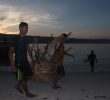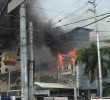Factors that may determine the strength of JI in different areas include:
? the existence of JI religious boarding schools (pesantren); a concentration of schools is likely to produce a stronger base and more opportunities for recruitment;
? the history of Darul Islam/JI in the area; the JI structure in Lampung, which builds on a DI base going back to the 1970s, is likely to be more difficult to dislodge than in Poso, where the wakalah was only set up in late 2002 (that said, DI�s strong influence in West Java has made it harder for JI to penetrate);
? the extent of overlapping ties among members, since the local structure is likely to endure when individual members have family and business connections that reinforce organisational ones;
? success of campus-based recruitment, including at secular universities; and
? the degree to which recruiting takes place in prison and the activities of JI prisoners once released.
Of all these factors, the most important may be the schools. Numbering about twenty, mostly on Java, they are important as administrative centers and the bases from which religious outreach takes place. The rise and fall of their enrollment may be the best guide to JI�s institutional health. Student intake at Pesantren al-Mukmin in Ngruki reportedly fell dramatically in the year after Abu Bakar Ba�asyir�s arrest but reportedly has climbed following his release.
The following sections address each of the nine wakalah administered by Mantiqi II � Central Java, Solo, East Java, Lampung, Jakarta, West Java, northern Sumatra, central Sumatra and West Nusa Tenggara � as well as the three in Sulawesi, in what used to be Mantiqi III and which now may have been brought under the same administration as the others.
In JI�s organisational structure, the wakalah were divided into progressively smaller sub-units: sariyah, katibah, qirdas, fi�ah and thoifah, each roughly corresponding to a military unit. But in practice, many wakalah had only two or three subdivisions, and according to a former JI member, only Solo was large enough to have the full complement.
A. CENTRAL JAVA
The Central Java wakalah, based in Semarang, was from the outset one of the most important and second only to Solo in size. It was part of JI�s heartland; much of the region was old Darul Islam territory, and its leaders were prominent on the JI central command. Its territory included an important JI school, Pesantren al-Muttaqien in Jepara, whose head, Sartono, was one of the early wakalah heads (1998-2002). In July 1999, the wakalah had five katibah: Pati (including Kudus and Jepara); Semarang; Kedu (including Temanggung, Sleman and Magelang); Pemalang (including Pekalongan, Brebes and Tegal); and Purwokerto (including Banyumas and Cilacap). Testimony of JI prisoners arrested in 2005 suggests there was no major change in that basic structure over the intervening six years.
A June 1999 document on dakwah (religious outreach) development for the wakalah gives some baseline figures. Each katibah had or was looking to appoint regional coordinators for its territorial subdivisions. At the time, it had 25 in place, some of whom covered more than one area, and seven vacancies. The presence of a regional coordinator was evidence of a well-developed structure that could sustain a range of activities, including charitable foundations (yayasan) that provided some of the basic operating expenses for the organisation. The wakalah also had a roster of 54 preachers and teachers, each of whom would have been involved in recruitment and most of whom were involved directly in leading halaqah (study circles). By 2000-2001, some on the list had been sent to Ambon and Poso. Some, like Ust. Sahl, ended up staying in Poso to build up the JI structure there; others, like Subur Sugiarto, who went to Ambon, returned to Central Java. But the document noted a major weakness of JI preachers was that most lacked advanced degrees and therefore had little legitimacy in the eyes of the public.
The document also noted that recruiting was more successful in rural than in urban areas. To improve results in the latter, leaders were to concentrate on schools and campuses, with particular focus on setting up university-based dakwah organisations. The document suggests total membership was at least several hundred in 1999, and it probably peaked in 2000-2001, when the Ambon and Poso conflicts were at their height and before the Bali bombs frightened some away. Trends in different katibah suggest today�s figure may be in the 150-200 range.
One question is how far the support network extends beyond the membership. While a definitive answer is impossible, one example is a broader forum of Islamic organisations, FORKIS (Forum Aktivis Islam Semarang) that JI came to dominate. Some of its non-JI members agreed to provide logistic assistance to Noordin in 2005 when requested to do so, and there are undoubtedly other organisations, workplaces, and family networks where non-members are drawn into JI support whether or not they know about � let alone agree with � the organisation�s aims.










